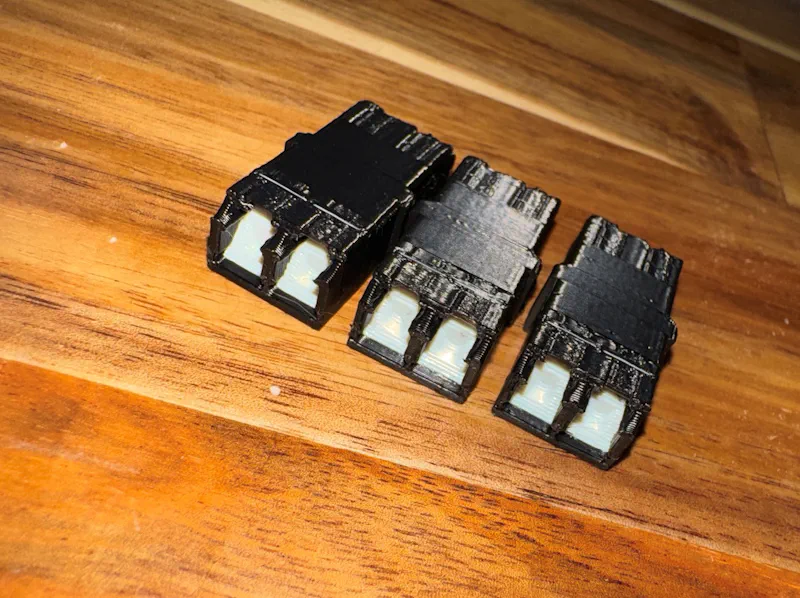I wanted to share some photos of some of our early prototype adapters, but I think its important context to understand WHY we think adapters are so important.
The Adapter is One of the Most Critical Components in Fibre Optic Communications
It’s small. It’s cheap. It rarely gets discussed. And yet, when it’s wrong, they can mean the entire channel fails.
Adapters are one of the most overlooked components in fibre connectivity, right up until they’re the reason your link doesn’t pass testing. I’ve seen it too many times, low repeatability, high loss, and dust ingress over time. These often aren’t upfront catastrophic failures. They’re the kind that slowly chip away at network performance, day after day.
At ScaleFibre, we decided to invest the time and energy into making sure adapters deliver low loss, high repeatability and inherent protection from contamination. Because when you build infrastructure that matters, every link in the chain matters.
The Problem With Commodity Thinking
Let’s call it what it is. Most adapters on the market are engineered to meet the lowest possible price point, which inherently means delivering the lowest possible standard. Questionable materials for alignment sleeves, dust caps that often never find their way back into the adapter after testing, odd shaped mounting flanges, and inconsistent retention clips. These are the silent contributors to long-term degradation in high-density environments.
They might be cheap. But they’re not cost-effective when you factor in site visits, re-testing, rework, or signal loss.
We were not happy with that compromise, so we rebuilt them. Not to innovate for innovation’s sake, but to eliminate the compromises others treat as normal.
Our Design Principles
Every ScaleFibre adapter is built with three principles in mind: precision, protection, and production consistency.
- Ceramic split alignment sleeves (zirconia) – These deliver tighter centring tolerances and repeatable low-loss performance. We don’t mix materials or use metal blends that wear down over time.
- Shutter-first dust protection – Built-in shutters engage automatically, so there’s no need for dust caps on the front side of the adapter. It protects both the connector behind the panel, and the technician installing it from any laser hazard.
- Form factor matters – Standards compliant body, colour-coded variants, clip compatibility and panel fit have all been tested and refined.
- Mould and materials control – We control the materials used to ensure the geometry, performance and strength are consistent.
Adapters aren’t glamorous, but we still believe they should be treated as a critical element.

From Prototype to Production
We started with fast-turn prototyping in-house. Using 3D printed shells, we developed a range of concepts to evaluate for look, feel and operation. Our goal was to understand the ideal concept before we needed to develop any tooling.
In production we move to precision injection moulding with tooling designed for volume production, fine tolerances and excellent repeatability. We specify particular virgin polymer blends including polycarbonate (PC) and polybutylene terepthalate (PBT), depending on the adapter type. The polymer is important because it provides not only the basis for mechanical performance of the finished adapter, but also contributes to the shrinkage and dimensional tolerances. Cheaper non-virgin blends or other polymers can mean poor mechanical performance and out of tolerance dimensions.
In a similar way, our sleeves are sourced from established ceramic manufacturers. These are critical, and not all ceramic sleeves are made equal. Cheaper ceramic sleeves have poorer dimension tolerances and suffer issues with repeatability and loss. For our adapters, we use quality ceramic alignment sleeves, and each production batch undergoes insertion loss sampling and dimensional verification.
It’s a simple component, built with zero tolerance for sloppiness.
Why It Matters
An adapter is not just a passive component. It sets the alignment between ferrules. It controls how much dust enters the mating point. It determines whether the connector locks in confidently or flexes, degrades and fails silently over time.
And in a typical deployment, you’ll have hundreds or thousands of them.
That’s why we put real engineering effort into something most of the industry treats as an afterthought. Because your fibre network is only as good as its weakest point. And this one doesn’t need to be weak.
Built to Scale. Built to Stay Out of Sight.
Once it’s in the panel, you shouldn’t have to think about it again. That’s our benchmark.
We’re beyond prototypes now. Our adapters are in production right now, available across LC, SC, and hybrid form factors. If you’re specifying products for a build, or tired of second-rate accessories undermining your install quality, we’d love to show you what a proper adapter looks like.
Reach out for samples or follow us on LinkedIn or X to see what’s next.



